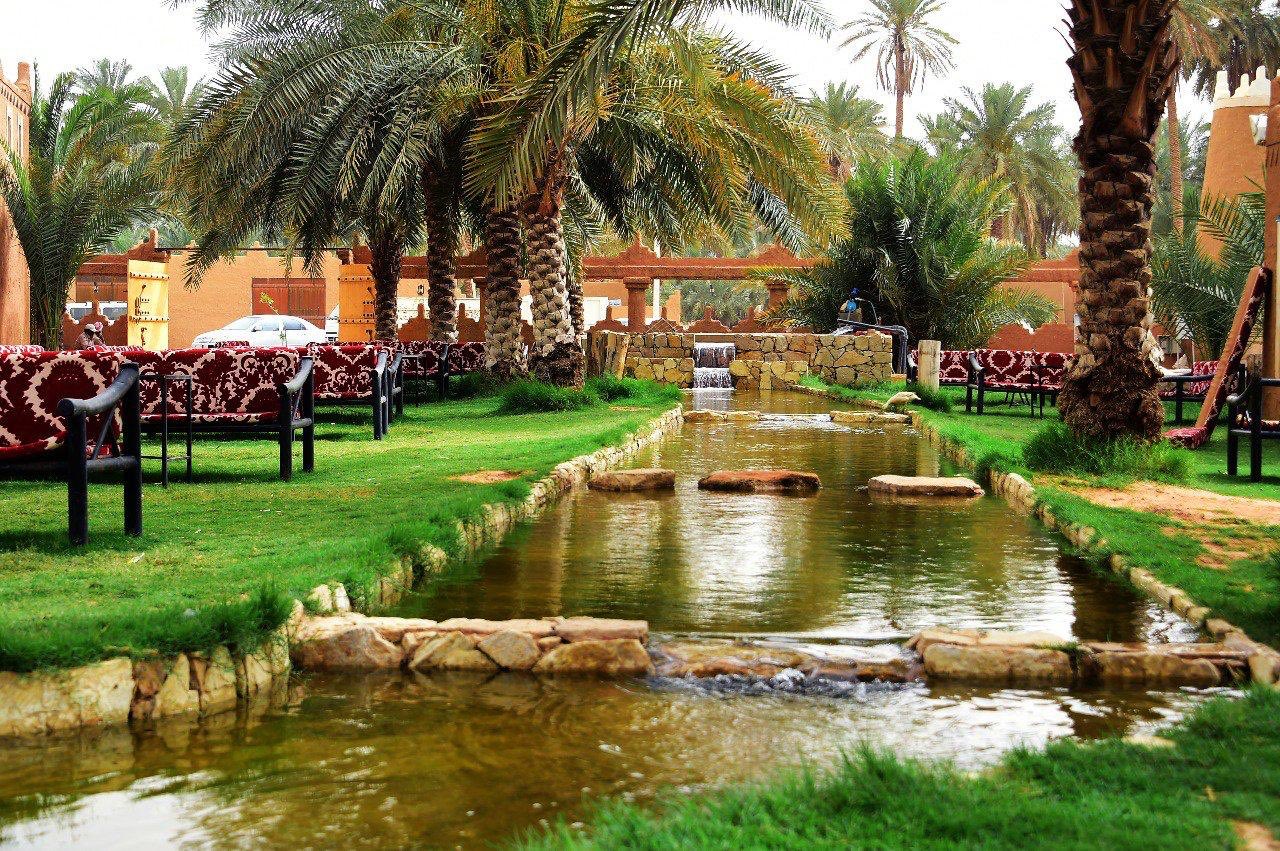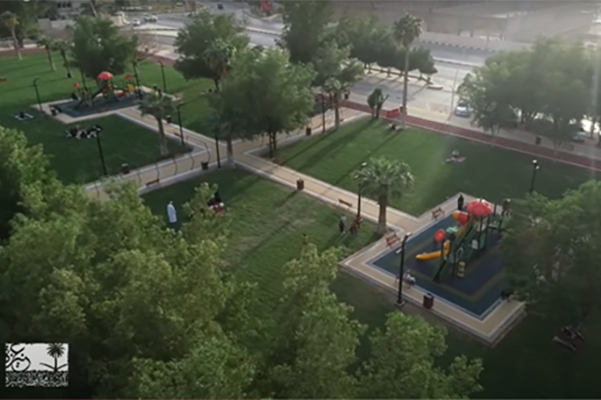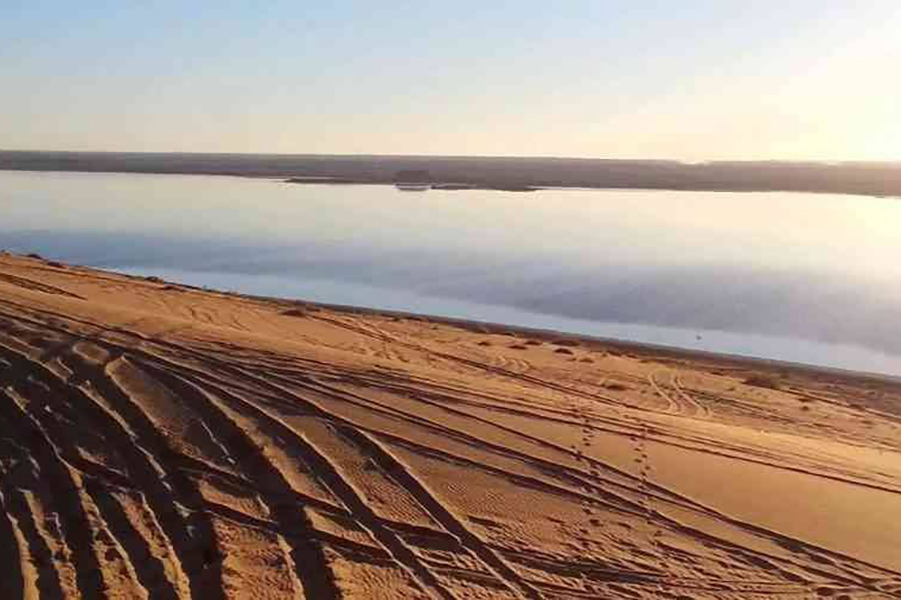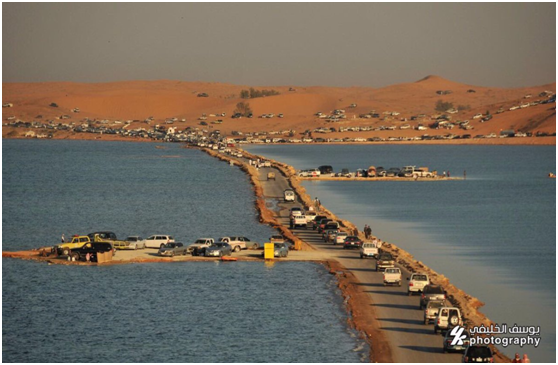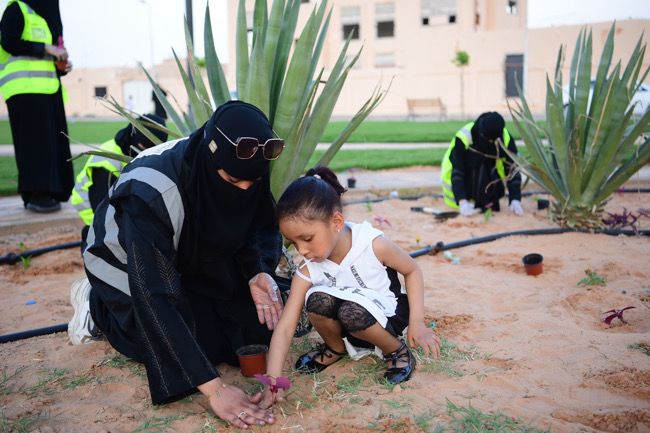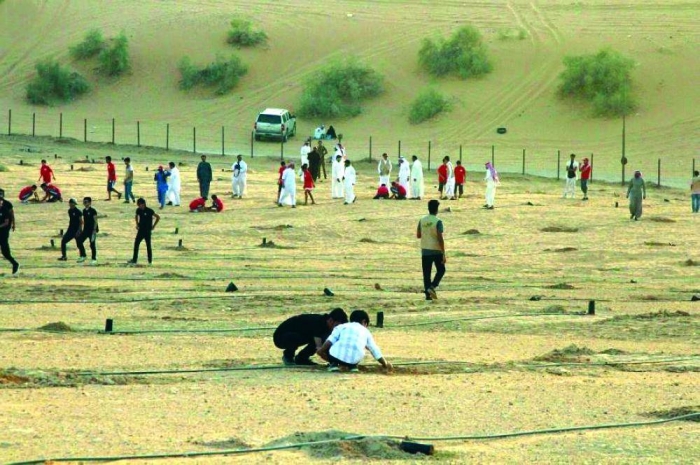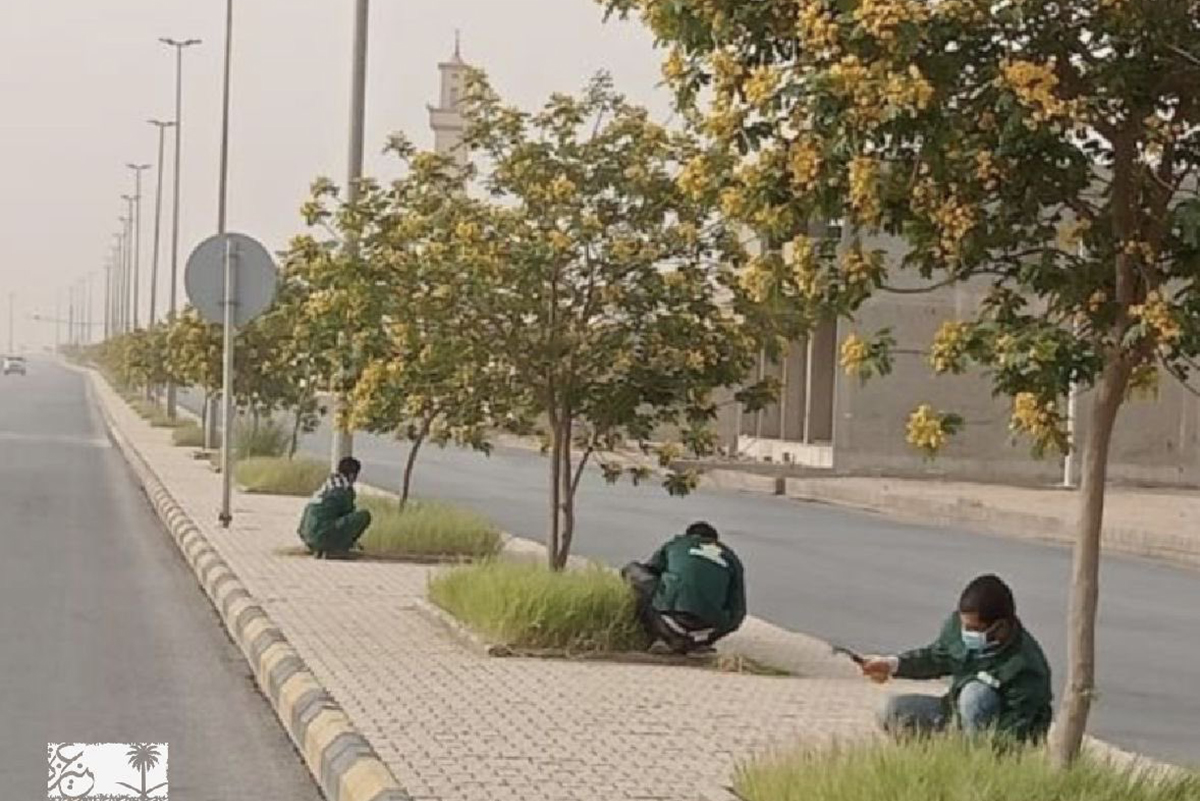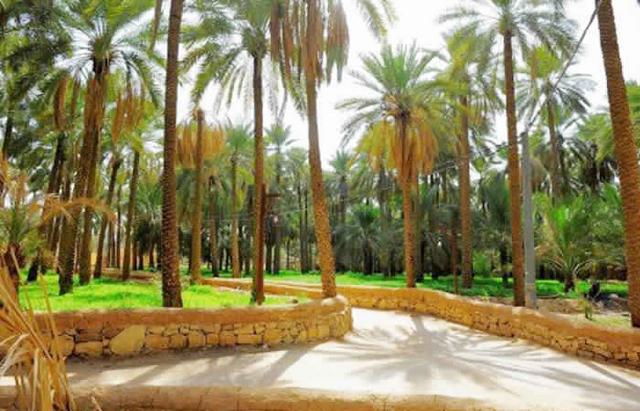Benefits of Urban Greening
Harnessing the Power of Plants
Scientific research indicates the ability of ecosystems and plants to offer a multitude of benefits to humans and the environment. Green spaces and plants not only reduce pollution and improve air quality, but they also contribute to lowering ambient temperatures. Additionally, parks and gardens are ideal venues for enhancing mental health, providing spaces that support relaxation and contemplation.
With this in mind, we’ve witnessed a rise in tree-planting initiatives and the transformation of underutilised farms into rural parks. These initiatives, in addition to their environmental benefits, work as a tourist attraction and promote sustainable tourism within the city.
This approach seeks to heighten environmental and cultural awareness among visitors, offering a unique experience that allows them to appreciate the beauty of nature and understand the importance of conserving it. By adopting this strategy, a city can transform into a green oasis enjoyed by its residents and visitors.
In the long run, such initiatives may play a pivotal role in redefining the concept of a city, emphasising sustainability and quality of life. Simple acts, like walking among trees or sitting beside a clear river, can have a profound impact on individuals’ lives. In conclusion, innovative initiatives in the realm of nature tourism provide opportunities for cities to adopt a sustainable model that respects the environment and delivers exceptional experiences.
Delivering Multiple Benefits
Scientific studies on the desert plant “Al-Ghada” reveal its distinctive abilities in supporting environmental sustainability and confronting extreme phenomena resulting from climate change. Among the prominent features of the Al-Ghada plant are:
- Extremely limited water consumption.
- Roots that spread both horizontally and vertically in the soil, enhancing its cohesion and stabilisation.
- Provides a safe refuge for desert creatures, contributing to the restoration of the region’s ecological balance.
- Assists in reducing temperature levels and contributes to oxygen production, while helping decrease harmful pollutants, such as carbon dioxide.
- Acts as a natural barrier against sandstorms, limiting their movement and preventing their advance towards cities.
Adopting desert plants in restoring ecosystems is part of the local planning strategy, as outlined in the Kingdom’s Vision 2030. This approach also aligns with the United Nations’ commitments as per the seventeen Sustainable Development Goals, especially:
Goal 3: Ensuring good health and well-being for residents of the concerned areas.
Goal 13: Addressing pollution through climate action.
The City’s Bold and Innovative Vision
Based on the principle of community participation and raising environmental awareness among all societal segments, the association adopted various campaigns and initiatives targeting the general public. The goal was to emphasise the importance of combating desertification and the value of urban greenery. To accomplish this, numerous events engaged university students, institutional employees, charitable and sports associations, and other stakeholders.
The association’s efforts didn’t stop there. They took bolder steps to expand their reach, initiating active campaigns in cafes and educational centres to advocate for reduced waste and resource consumption. They also provided various individuals, including drivers and pedestrians, with saplings to plant, coupling this with the necessary awareness of the importance of voluntary efforts to preserve regional ecological and biological diversity for a greener future.
Moreover, the association leveraged modern technology to ensure effective participation, such as launching the “Eco Care” app. This app facilitates identifying areas needing environmental volunteers’ attention, speeding up the cleaning process and pollution elimination. The app aims to:
- Remove 1,000,000 tons of waste from wilderness areas.
- Plant 10,000,000 trees over three years, producing over 1,200,000 tons of oxygen annually.
- Motivate community members by showcasing transformed locations (before and after images).
Additionally, the association adopted innovative techniques for more efficient execution, such as:
- Using advanced drones to pinpoint suitable planting locations and employing aerial seeding techniques.
- Leveraging technology for irrigation and treating wastewater, repurposing it for afforestation purposes.
Partnerships and Collaboration
Highway engineers can utilise their expertise to design eco-friendly roads incorporating green spaces, pedestrian paths and bicycle lanes, reducing pollution and enhancing air quality. These designs should also allocate space for trees.
Water engineers are essential in devising efficient water recycling and rainwater management systems, contributing to water conservation and pollution reduction. This includes extending irrigation networks to farms and parks, ensuring a consistent water supply for trees.
Health professionals can advise on the health benefits of green spaces, ensuring city designs promote health and wellbeing. Their expertise includes identifying plants beneficial for eradicating harmful insects or those harmful to humans and recommending environmentally friendly alternatives.
Urban planners and architects must collaborate to integrate green spaces into urban designs, making cities more appealing and healthier, such as planning home gardens in city house designs.
Artists can utilise art to raise awareness about the significance and aesthetics of green cities, championing initiatives, plays and films to bolster environmental awareness.
Sociologists can help cities understand the impact of green spaces on social interactions and enhance societal cohesion and communication.
Sustainable collaboration among these professionals can actualise the vision of a green city and ensure its future sustainability. Collaboration can also extend to non-specialised entities, like educational institutions, encouraging student involvement in environmental initiatives, organising cleanliness and conservation weeks during winter, and granting students volunteer points.
Addressing Urban Challenges
The Issue
The escalating phenomenon of global warming, accompanied by various climate change manifestations, is an undeniable reality that we can no longer overlook. Cooperation is essential to combat these issues.
The Arabian Gulf region is becoming one of the planet’s hottest areas. This surge in temperature coincides with a significant scarcity of water and food resources. Consequently, it’s imperative to explore adaptive strategies tailored to the region’s current climatic conditions.
The Impact of the Issue
This environmental predicament directly affects cities and their inhabitants. They face challenges such as accessing water resources, rising temperatures and increasing desertification. This desertification leads to frequent dust storms, causing various health, economic and psychological issues for residents. Desertification is among the most significant environmental and ecological challenges in the Arabian Gulf region. As a result of climate change and increasing global temperatures, the vegetation cover recedes, leading to further temperature rise and disrupting certain ecological systems, evidenced by the disappearance of animals that rely on such vegetation.
Litter, including paper and plastic waste, is dispersed across observed and unobserved areas by winds and storms, requiring cleanup efforts. If no proactive measures are taken, involving city residents and volunteers, to address these problems and to fulfil one of the main Sustainable Development Goals (SDG 11: Making cities inclusive, resilient and sustainable), these challenges might intensify. This escalation would adversely affect residents’ psychological and social wellbeing, leading to economic decline. Ultimately, this may force inhabitants to make difficult decisions, such as relocating entirely in search of better opportunities elsewhere.
A Nature Orientated Future
As previously explained, the association located in Unaizah City aims to address environmental issues. To ensure effective intervention, the association adopts natural methods derived from plants and the environment as solutions to these issues, aiming to restore the lost ecological balance in the region. In addition, it employs modern techniques to maximise the benefits of its initiatives.
To combat the detrimental phenomenon of desertification, the association took an interest in planting the ‘Ghada’ plant. This plant stands out for its resilience to harsh climates, requiring minimal water, anchoring sandy soils with its widespread roots and providing shelter for various creatures. Although its population hasn’t reached extinction, revitalising this essential component of the ecosystem is a significant victory. Re-establishing the vegetation cover will improve temperatures and counteract sandstorms and their undesired effects. The association also encourages community through volunteering or by distributing free seedlings for planting.
With the rise of paper and plastic waste in the city, the overall appearance negatively impacts tourism projects. To ameliorate the situation, the association supported community participation in cleanliness initiatives to elevate environmental awareness, with a special focus on youth and employing advanced technologies like drones.
Nature Positive Solutions
Implementation
The Kingdom has addressed environmental challenges through a sophisticated scientific approach, leveraging specialised academic teams to identify and mitigate the negative impacts of these issues. In this regard, the Kingdom offered robust support to environmental associations by providing political and economic backing and promoting leadership involvement in environmental initiatives. Moreover, community support was strengthened by engaging civil society and scientific entities, manifested in launching a unique environmental application that allows immediate pollution reporting.
Over time, with heightened commitment to environmental enhancement, there has been a noticeable improvement in the Kingdom’s environmental state, aspiring for ecological balance, marked progress in public sanitation and eliminating pollution sources.
Similarly, the City of Unaizah witnessed significant progress over the past five years:
2018: Emphasis was placed on eco-farms, attracting visitors and tourists, benefiting agriculturally and aesthetically.
2019: The ‘Green Unaizah League’ team was established, a volunteer group specialising in environmental initiatives across different seasons.
2020: Amidst the COVID-19 pandemic, governmental bodies enhanced the City’s aesthetic appeal by planting trees, installing lighting and beautifying buildings, enriching its civil image.
2021: The ‘Ghada Environmental Association’ was introduced, acting as the official environmental representative for the City.
2022: Both the City and the association achieved global distinction, clinching first place in the Guinness World Records for having the most extensive vegetation cover.
Feasibility
Our association aims to significantly impact the environmental scene by focusing on core objectives. These include raising environmental awareness, integrating volunteer work with the association’s duties, collaborating with relevant entities and supporting local environmental research and studies.
The Afforestation Project stands out as one of the association’s major endeavours, influencing other projects and introducing changes to flora, the environment and native fauna over five years. The project’s goal is to plant 100,000 saplings over the next five years, which will profoundly affect local plants, the environment and living organisms.
The project has an allocated budget of 3,500,000 riyals for the first phase, with a cost of 35 riyals per sapling, including irrigation and protection for three years. The success of our initiative will profoundly influence the city’s planning and policies for the following reasons:
Environmental Focus:
- Achieving the association’s objectives will prioritise the environment in the City’s development and planning agenda.
- Collaboration with Relevant Entities: Enhanced collaboration is expected with relevant entities, leading to the implementation of more effective environmental policies and regulations.
Promotion of Volunteerism:
- The initiative’s success will motivate more individuals to engage in environmental volunteer activities, playing a pivotal role in shifting the local culture towards increased environmental care and protection.
Multi-Stakeholder Support
Supporting the Green City Initiative is a cross-disciplinary endeavour that transcends individual sectors. Only through holistic efforts can cities actualise their green visions.
Collaboration with highway engineers is crucial. Their expertise in designing eco-friendly roads that incorporate green spaces, pedestrian pathways and bike lanes can drastically reduce pollution and enhance air quality. Prioritising areas for afforestation aligns with the City’s green objective. Water engineers ensure effective water recycling systems and rainwater management, reducing water consumption and shielding water sources from pollution. Continuous irrigation networks are vital for tree sustenance.
Health professionals offer insights to maximize the benefits of green spaces, making the city a beacon of health and wellness. Advice on plants that counter harmful insects guarantees a clean and safe environment.
Urban planners and architects ensure the integration of green spaces into urban designs, beautifying and health-proofing the city. Home garden initiatives further the environmental cause.
Artists play a pivotal role in amplifying the importance of the green city. Artistic endeavours foster environmental awareness across societal segments.
Sociologists understand and evaluate the socio-interactional impacts of green spaces, promoting societal communication and cohesion.
Lastly, by fostering non-specialist partnerships, like those with educational bodies, harnessing youthful energy in environmental initiatives, such as environment-focused weeks and promoting volunteerism, becomes feasible.
In essence, through sustainable collaboration among these diverse expert groups, the Green City vision can be realised and ensured for future generations.
Management and Maintenance
The City is distinguished by its provision of numerous and varied services, in collaboration with private sector companies. These partnerships extend to firms specialising in road paving and maintenance, as well as those focused on city cleanliness. The City strives to ensure the delivery of essential services to its citizens, from potable water and sewage systems to waste collection.
Through its Planning Department, the City establishes strategic urban development plans and sets construction regulations, emphasising the importance of planning for rural parks. The significance of maintaining and upgrading the infrastructure is reflected in City greening efforts and public park improvements. In an environmental context, it promotes initiatives to enhance and preserve the environment, such as street planting.
In the business realm, the City oversees and issues business licenses, while encouraging the initiation of commercial projects within parks. Citizen health remains a priority; it monitors food and restaurants and provides health services. Moreover, it ensures readiness to handle emergencies by developing natural disaster response plans.
Measuring and Reporting Impact
Monitoring Results
The Environmental Growth Association has established various protocols containing Key Performance Indicators (KPIs) to monitor progress in implemented projects. The aim is to assess performance, identify strengths, optimise opportunities and address weaknesses. The association set several goals to achieve over time, ensuring continuous improvement. One such goal was to plant a record-breaking number of environmental growth plants, which was realised and recorded in the Guinness World Records in December 2021. The objective wasn’t just recognition but to exemplify the power of will in achieving environmental goals and gaining global respect.
Post the launch of the “Environmental Growth” mobile application, some performance evaluation indicators include:
- Engaging 100,000 volunteers in three years.
- Removing 1,000,000 tons of waste from wilderness areas.
- Planting 10 billion trees in three years, producing over 1,200,000 tons of oxygen annually.
- Collaborating with Gulf nations to plant 40 billion trees.
- Reducing paper waste by encouraging café-goers to use their cups.
- Inspiring community members to be environmentally responsible by showcasing worked-on sites (before-after).
- Promoting environmental conservation and safety.
- Conducting oral surveys among city residents to gauge the association’s reach.
- Achieving the initiative’s goals will benefit City inhabitants by:
- Ensuring environmental sustainability.
- Transforming the City into a tourist attraction with renowned achievements.
- Increasing green cover and restoring the City’s ecosystem.
- Revamping parks, providing tourist attractions and psychological relief.
- Reducing paper and plastic pollutants, boosting tourism.
- Creating new job opportunities.
- Enhancing commercial and industrial activities due to improved environmental conditions.
Demonstrating Progress
Setting measurable environmental, economic and social goals enables the association to track its progress rates. Monitoring these rates against set timelines identifies potential hurdles and fosters solution development. The association deploys various oral and electronic surveys to gauge diverse participant opinions on initiatives, observe real-world business impacts, and consider potential novel suggestions for future goal-planning to ensure continuous improvement.
Working on an integrated plan to achieve these goals and monitor performance acts as a significant economic influencer for the City. It denotes the progress in restoring the City’s green cover, rejuvenating its ecological system, transitioning it to sustainability, conserving natural resources, mitigating severe climate change impacts like sandstorms, waste reduction, generating new job opportunities, transforming the city into an economic and touristic attraction, enhancing civic pride, and achieving global recognition through the Guinness World Records, spotlighting the city’s environmental milestones.
Achieving these outcomes paves the way for increased local and global attention, fostering a surge in City projects and strategies, thereby providing new job opportunities and elevating residents’ living standards.
The growing local and global attention towards the achievements in Unaizah City will stimulate related initiatives across the kingdom and abroad, attracting external stakeholders and new investment into this sustainable sector.
Measuring Impact
The initiative achieved several core objectives including bolstering green cover, reducing waste and augmenting community engagement. It also facilitated job opportunities for both men and women in the City, bolstering its sustainability and advancing numerous environmental and societal indicators.
In defining these goals, the association ensured a balance between quantitative and qualitative dimensions, to mirror the actual on-ground situation. A majority of these goals were quantifiable and measurable, adhering to global SMART standards, accompanied by qualitative ones highlighting narrative aspects.
Quantitative goals included:
- Removing a million tons of waste from wilderness areas within three years.
- Conducting oral surveys among City residents to evaluate the association’s progress and using results for performance enhancement.
Qualitative goals encompassed:
- Encouraging café patrons to use their own cups, decreasing paper waste.
- Motivating citizens to undertake environmental responsibility by showcasing cleaned areas.
- Promoting environmental conservation awareness.
- Enhancing the City’s green cover for ecological equilibrium.
- Seeking natural and technical solutions to minimise resource consumption.
- Leveraging modern techniques for environmental awareness elevation.
The association employed multiple communication channels with City inhabitants:
- Awareness seminars City-wide.
- Inviting residents for voluntary initiatives.
- Launching the “Environmental Pledge” app for consistent engagement.
- Introducing a website detailing the association’s environmental endeavours.
- Submitting annual reports to national authorities for sustained support.
Learning and Transferability
Adaption and Enhancement
Starting with collaboration from experts of scientific and academic backgrounds during the planning stages, the society has set objectives, general policies and identified necessary resources – human, economic, logistical, technological, and more. Operations are executed following global standards, specifically the Best Available Techniques. Performance indicators are then measured to assess execution rates and make necessary adjustments, ensuring continuous improvement.
Based on the KPI review results and a survey distributed to City residents, several changes were proposed: new volunteer locations, expanding volunteer categories to include foreigners and officials, and employing modern techniques for waste monitoring throughout the City, among other continuous improvement objectives.
The society has ensured the involvement of all stakeholder categories in the initiative:
Internal Stakeholders: This group includes citizens, the general public, government entities and national institutions. They’ve supported volunteering efforts, raised environmental awareness and facilitated waste disposal.
External Stakeholders: This comprises international entities like the United Nations, the Guinness World Records, and neighbouring and foreign countries. These entities have elevated the society’s ambitions, aiming for global sustainability goals (17 UN goals), providing motivation to achieve global recognition via Guinness World Records, and partnering with neighbouring Gulf countries to plant 40 billion trees, enhancing the region’s ecosystem.
Potential for Replication
Knowledge Transfer:
When an initiative is designed to include knowledge transfer it signifies the City has shared acquired information and techniques from the implementation with other cities or partners. This transfer can occur via workshops, training courses, documents or case studies highlighting lessons learned and best practices.
Shifting Mindsets:
The City’s pivot towards an environmental ethos may have encouraged partners and factories to reconsider their policies and production methods to be more environmentally friendly.
Tourism Impact:
As noted, the City has become a tourist destination due to its focus on rural parks and environmental initiatives. This attention has attracted new visitors, positively impacting the local economy through increased tourism.
Attracting Investment:
The boost in tourism has drawn new investments to the City, especially in the park areas. This implies new job opportunities, infrastructural improvements, and possibly a rise in hospitality services like hotels and restaurants.
Unanticipated Changes:
While the initiative’s primary focus was environmental conservation, there may be unforeseen changes it brought about. For instance, an enhanced environmental awareness among local residents or shifts in their daily consumption choices and behaviours.
In conclusion, environmental initiatives have long-term impacts that surpass their primary objectives.
A city aiming for sustainability might find itself in a favourable position to attract tourism, investments and achieve sustainable development.
Inspiring Other Cities
As noted in scientific literature, the Arabian Gulf region is among the most prominently affected areas by global climate change impacts. This region faces an amalgamation of accelerating desertification rates, dwindling water resources and heightened pollution levels, leading to the degradation of vegetative cover and disruption of some ecosystems.
Gulf states stand united against these challenges with regional collaboration evident in joint ventures, such as the ambitious initiative to plant 40 billion Ghada trees. Given the environmental similarities, attention shifts towards the successful endeavours of Unaizah City, potentially prompting neighbouring countries to benefit from the practical expertise garnered by the Kingdom.
The environmental organisation Ghada added significant value when honoured by the Guinness World Records, serving as an incentive for adjacent nations to adopt similar initiatives. Such endeavours are anticipated to yield positive outcomes, improving environmental balance, bolstering tourism and creating job opportunities, alongside other benefits aiming for sustainability.
Resilience
Reducing Negative Impacts and Ensuring Sustainability
In alignment with the Kingdom’s efforts to reduce carbon emissions resulting from various activities, especially those from burning fossil fuels, the initiative has committed to minimising the use of transportation. This is achieved by collaborating with local volunteer entities and institutions close to the initiative’s sites and employing modern technologies, such as drones and smart apps, instead of fuel-operated planes or cars to monitor pollutants.
Environmental Considerations
During the initial stages of planning for the initiatives undertaken by the Ghada Environmental Association, requisite environmental and societal studies were conducted. These studies identified all environmental aspects, such as resource consumption, waste generation, emissions, etc. The potential impacts of these aspects due to the planned activities were examined to ensure minimal negative repercussions and amplify positive opportunities arising from the association’s actions.
All resources and inputs utilised were evaluated from a life cycle perspective, starting from project planning and concluding with the completion and waste disposal, if any. Based on these studies, it’s deduced that all intended initiatives and activities will positively impact the broader environment, particularly in the Unaizah region. These initiatives align with the city’s climatic needs, aiding in restoring its environmental and biological balance disturbed by climate change and ongoing resource depletion.
The projects did not excessively consume natural resources. Volunteer services were utilised with a limited number of vehicles for waste transportation to recycling or final disposal sites. Advanced techniques were employed for irrigation and wastewater treatment, negating the need for drinking water sources.
The initiatives provided community development opportunities, involving diverse city sectors: both genders, youths, seniors, children, expatriates, drivers, café-goers, and many more. They also resulted in reduced usage of paper cups, diminished waste, rejuvenation of the region’s vegetation, establishment of recreational parks, and heightened awareness of the importance of desert plants like Ghada.
Use of Natural Resources
Paragraph 33 of the United Nations’ 2030 Sustainable Development Plan emphasises the interconnection between the sustainable management of Earth’s natural resources and socio-economic development. It advocates for strengthened cooperation in combating desertification, sandstorms, land degradation and drought, and enhancing resilience while minimising disaster risks. Goal 15 aims to “safeguard and restore terrestrial ecosystems, sustainably manage forests, counteract desertification, halt and reverse land degradation, and arrest biodiversity loss.”
Drawing on the aforementioned points and aligning with Vision 2030 of the Kingdom, the association, through various initiatives, transformed numerous underutilised farms due to their location into rural parks. These parks not only created a tourism surge but also significantly improved the mental wellbeing of city inhabitants and visitors. Tree planting campaigns within residences lowered indoor temperatures by reflecting more sunlight, thereby positively affecting the inhabitants’ physical and mental health.
All activities undertaken in this initiative were geared towards being resource-neutral and fully sustainable. The cultivation and preservation of the Ghada plant and the pledge to ensure its continuity while refraining from using it as a polluting fuel source resulted in achieving sustainability – preserving natural resources and restoring ecological balance while revitalising the animal ecosystem linked to this plant. The Ghada plant consumes minimal water compared to other plants, thus effectively conserving a crucial resource like water. Advanced irrigation techniques and wastewater treatment were employed, ensuring potable water sources remained untouched.
















